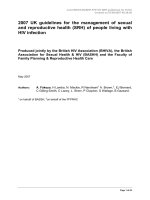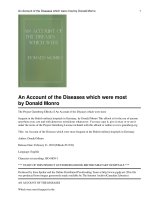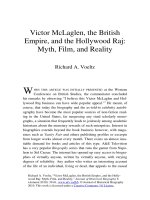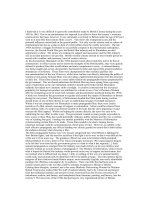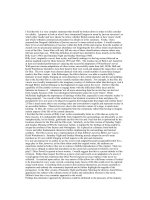The moths of the British Isles
Bạn đang xem bản rút gọn của tài liệu. Xem và tải ngay bản đầy đủ của tài liệu tại đây (22.58 MB, 522 trang )
iTowlanu
16*7
WARD
Ltd.,
PICCADILLY,
I
ONDON.
TM£
Vtuxe*'
•
rJgLi~.
;
II
j
I
j
I
22102090063
Med
K7039
THE VOLUMES
A LIST OF
IN
THE
WAYSIDE AND WOODLAND SERIES
WAYSIDE AND WOODLAND BLOSSOMS
Pocket Guide to British Wild Flowers, for the Country Rambler.
A
and Second
(First
With
Series.)
And
EDWARD
By
clear Descriptions of 760 Species.
Coloured Figures of 257 Species by
MABEL
E.
STEP, F. L.S.
STEP.
*
WAYSIDE AND WOODLAND TREES
A
EDWARD
STEP, F.L.S.
By
Pocket Guide to the British Sylva.
E. STEP
With 175 Plates from Water-colour Drawings by
Author.
the
and
IRVING
and Photographs by
MABEL
HENRY
*
WAYSIDE AND WOODLAND FERNS
A
Pocket Guide to the British Ferns, Horsetails and Club-Mosses.
STEP, F.L.S.
By
EDWARD
With Coloured Figures
And
of every Species by
MABEL
E.
STEP.
67 Photographs by the Author.
*
THE BUTTERFLIES OF THE BRITISH ISLES
A
With
Pocket Guide for the Country Rambler.
clear Descriptions
By
and
Life Histories of all the Species.
RICHARD SOUTH,
F.E.S.
With 450 Coloured Figures photographed from Nature, and numerous
Black and White Drawings.
*
THE MOTHS OF THE BRITISH ISLES
(First
and Second
Series).
Pocket Guide to all the Species included in the Groups formerly
known as Macro-lepidoptera. By RICHARD SOUTH, F.E.S.
With upwards of 1500 Coloured Figures photographed fiom Nature,
and numerous Black and White Drawings.
A Complete
*
AT ALL BOOKSELLERS.
Full Prospectuses on application
to the
Publishers—
FREDERICK WARNE AND
London
New
15, Bedford Street, Strand.
York 12, East 33rd Street.
:
:
CO.
THE WAYSIDE
AND WOODLAND
JS
JS
SERIES
THE MOTHS
OF
THE
BRITISH ISLES
Digitized by the Internet Archive
in
2016
/>
.
I
pi'
[
i'
t.
2, 3 .
4.
Spurge
Hawk
:
caterpillar.
Hawk caterpillar.
Hawk caterpillar
Silver-striped
Oleander
:
:
Frontispiece
THE MOTHS
OF THE
BRITISH ISLES
BY
RICHARD SOUTH,
F.E.S.
AUTHOR OF
“THE BUTTERFLIES OF THE BRITISH
EDITOR OF “THE ENTOMOLOGIST,’’
ISLES”
ETC.
FIRST SERIES
COMPRISING
THE FAMILIES SPH INGID.-E TO NOCTUID.E
WITH
ACCURATELY COLOURED FIGURES
OF EVERY SPECIES AND MANY VARIETIES
ALSO DRAWINGS OF EGGS, CATERPILLARS
CHRYSALIDS AND FOOD-PLANTS
LONDON
FREDERICK WARNE &
AND NEW YORK
(
A It
rights reserved)
UGol -
i <1
olj
CO.
.
^
2
/
^
2-
a
o
A
WtLLCO'/
INSTITUTE
Lip" V
Col!.
Cali
No.
we’MOmec
PREFACE.
Compared
with our butterflies, the
the British Isles
is
of moths found in
Like the butterflies, moths too
very large.
are dependent upon plant
number
and almost every kind of herb,
nourish the caterpillars of one or
life,
bush, or tree, will be found to
more species of moth.
Not only the field botanist, but every rambler in the country
must constantly come across moths or caterpillars that will
probably interest him, and of which he would be glad to learn
something about their habits, life-history, and the position they
occupy in the arrangement and classification of Natural History
objects.
In
the
preparation
of this
little
book on our moths, the
author has proceeded closely on the lines adopted
when dealing
That is, the chief
aim has been to place before the nature lovers as much information concerning these creatures as could be condensed into
moderate limits.
Lengthy descriptions were out of the question, but what
might be considered an omission in this way, is amply com-
with the butterflies in his previous volume.
pensated for by the
life-like portraits
moths themselves, and
varieties.
the
in
many
of typical examples of the
cases of their more important
Technicalities have been avoided as far as possible,
main object being
to
provide a guide to the identification of
our moths, together with a simple account of the whole or a
part of their earlier stages.
PREFACE.
VI
The author
aware that
is fully
method
this
of treatment only
enables him to touch the fringe of the subject, as
he has been content to deal with it in this way, as
it
were, but
appeared
to be the kind of information that would most nearly meet the
requirements of the majority.
The author
Adkin, F.E
it
desires here to express his thanks to Mr. Robert
S., for
the loan of specimens of L. cocnosa E.
,
ilici-
D. harpagitla IV. albula N. centonalis D. barrettii,
D. ccesia P. xanthomista T. ex/re uia, L. favicolor, L. vitellina
and H. palustris. To Mr. Alfred Sich, F.E.S-, for the use of
drawings of the caterpillars of D. Mice, S. fagi, L. bicoloria
P. ridens A. auricoma, A. runvcis A. aceris N. brunnea
oleracea A. tragopogonis T. gothica and T. incerta.
To
Mr. H. L. Sich for the loan of drawings of the caterpillars
of D. euphorbice, D. galii D. chaonia and P. dictcea.
For the
folia
,
,
,
,
,
,
,
,
M
,
,
,
,
.
,
,
,
,
,
material figured on Plate 148, except the larva of L. pntrcsccns,
kindly sent by Mr. Walker, of Torquay, he
indebted to Mr.
is
H. M. Edelsten, F.E.S.
Except where otherwise mentioned, the illustrations of moths
and caterpillars at rest are from photographs by “A Forester.”
To Mr. Horace Knight he is very greatly obliged for the care
bestowed upon the drawings of ova, larvae, and pupae, the bulk
also the coloured
of which were made from living examples
;
drawings
for Plates
123, 140, 146, 149,
t,
and
45, 63, 68, 73, 75, 80, 84, 90, 108, 119,
153.
The only
figures copied from
any
previous publication are those of the caterpillars of S. fuliginosa
D. sanio D. pulchella A. cor ticca A. strigula N. plccta
,
,
,
,
,
,
and N. augur (Wilson’s “ Larvae Brit. Lep.”) and among the
moths, the varieties of A caia j D. mendica (4 Yorks.), Trans.
Ent. Soc. Lond., 1889; A. 7valkeri, Curtis, and N. subrosca,
;
.
Stephens.
THE MOTHS
OF THE BRITISH ISLES.
PART
T,
INTRODUCTORY.
As mentioned
in “ Butterflies of the
British Isles,” there
is,
speaking generally, no clear line of division between moths and
butterflies, and, as Dr. Sharp, in “Insects,” puts the case,
“ the
on ly definition that can be given of Heterocera [moths]
is
the practical one that all Lepidoptera that are not butterflies
are
Now,
Heterocera.”
in
it
happens that
all
the butterflies occurring
these islands have the tips of the horns (antenna?) clubbed
is much variety in the structure of the
horns
;
and, although there
of our moths,
none of them have the
tips
knobbed.
Like the butterflies, moths pass through the stages
of egg,
caterpillar, and chrysalis before they attain the
perfect state
(imago), and the duration of the several stages is
just as variable.
The majority assume the moth condition but once in the
but
year,
species have two, or even three, generations in
the
months, whilst others occupy twenty-four months
in
some
twelve
completing the
stage
may
life
cycle.
last four, five, or
In one or two species the chrysalis
even six years.
Diversity of form and structure is considerable
in the early
stages as well as in the perfect insects, and
this is shown in the
B
THE MOTHS OF THE BRITISH
2
ISLES.
selection of life-history details figured on the black
and white
plates in this volume.
Except that
it
is
generally less prominent, the head, with the
various parts thereof,
flies.
is
In a few families,
much
same as in the butterhowever, the “tongue” (proboscis) is
pretty
the
only rudimentary or even entirely absent
Fig.
;
while in others
it
is
i.
Convolvulus Hawk-moth and flower of Nicotiana.
(Photos by
very long.
W.
J.
Lucas.)
The Convolvulus Hawk-moth has
the proboscis of
able to reach the deep-seated nectary of
such tubular flowers as those of Nicotiana affinis. In the illus“
tongue ” of the moth and the sweet-scented tobacco
tration the
blossom are shown on exactly the same scale.
A,
Fig. 2 represents some forms of antennae found in moths.
such length that
it
is
INTRODUCTORY.
3
thickened and spreading out towards the tip ( dilate ) B, simple,
thread-like ( filiform ) structure, without teeth, hairs, or bristles
;
;
C, fringed with fine hairs
and with longer
bristles
(
ciliate )
;
D, fringed with
at the joints
(
fine hairs,
setose ciliate )
;
E, the
on the
tufts from
fringe in tufts {fasciculate)-, F, toothed, with fine hairs
teeth
{dentate ciliate )
G,
;
toothed with hairs in
the teeth {dentate fasciculate)
;
H,
I,
with double rows of hair
Antennse of Moths.
scales {bipectinate)
;
in
I
the projections are continued to the
and are themselves fringed with fine hairs, giving the
antennae a very feather-like appearance the term “plumose”
is sometimes used to describe this form of antennae
in H the
pectinations do not reach the apical fourth, which is simple. J,
tip,
—
;
the lamellate that
,
is,
the undersides of the rings or joints are
made up of minute plates.
The wings of a moth are
practically identical with those of a
diagram “ Butterflies of the British Isles,” p. 12).
Normally the fore wings have twelve ribs or veins, and the hind
butterfly (see
THE MOTHS OF THE BRITISH
4
ISLES.
wings eight, but in some genera a rib, or perhaps two, may be
absent from the fore or the hind wings or an extra rib, sometimes two, may be found on the hind wings. These modifications, and others, of the general plan of neuration have been
employed as a basis upon which
;
to
found genera, or to group them
together in classification.
by
Fig. 3 shows the arrangement
which the upper and lower wings
of a
6
9
Fig.
The
{frenulum) arising from the
base of the hind wing is held in
place by the catch {retinaculum)
3.
Connecting Bristle
and Catch.
It will
in flight.
bristle
-
wing.
moth are united
on the costal nervure of the fore
be noticed that the
bristle of the
male
is
longer
and firmer than that of the female. The latter, moreover, is
the catch, too, in the
usually made up of two or more strands
female is on the median instead of the costal nervure. These
structures are found on the under side of the
;
wings of most moths, but they are absent in all
The Emperor, Kentish Glory, and
butterflies.
Eggars may be mentioned as examples of moths
lacking
the
connecting
bristle,
but
all
these
have feather-like antennae, which terminate in a
The Burnets have the antennae gradually
point.
thickened towards the
this respect are
tip
somewhat
moths have a frenulum.
The hind wings of the
(A. Fig.
and
2),
in
butterfly-like, but these
Fig.
4.
The Jug-um,
or Yoke.
and a few others grouped with
and these moths have a jugum 01
Swifts,
them, have twelve veins,
from the inner
yoke (see Fig. 4). This is a flap-like projection
,
serve to conmargin, near the base, of the fore wing it may
it does not seem to
nect the wings when the insect flies, but
be capable of giving much help in that way.
;
INTRODUCTORY.
5
moth various markings, etc., have to be
may assist the reader more easily to locate
the usual position of such characters the accompanying diagram
has been prepared. The lines crossing the fore wings from the
In
describing a
referred
front
to,
and as
it
edge, or margin (costa), to the inner edge, or
margin
(dorsum), are generally styled transverse lines ; the short one
is the basal
the first long one is the inner, or antemedial
;
;
the second
is
the outer, or postmedial
Fig.
;
and the
third
is
the
5.
Wing-s and Body of a Moth.
'lform stigma
o.l.
;
outer line
orbicular
«./. apical
o.s.
;
submarginal, or subterminal.
The whole wing, less the margins
sometimes called the disc
but it is more convenient to
divide the fore wing into three
parts, naming that between
the base of the wing and
the first line the basal area
the
space between the first and second
lines the central or
median area, and the part beyond the
second line the outer
area.
The more or less round or oval rings or
dashes on
is
;
;
THE MOTHS OF THE BRITISH
6
ISLES.
and these characters occur
more especially in the Noctuidse. The hind wings usually have
a fine short line, crescent, or spot, at the end of the cell, as in
the butterflies, and there is generally a line or band beyond.
Immediately behind the head and covering the front part of
this is the
the thorax is a tippet-like arrangement of scales
the central area are the stigmata,
;
On
each side of the thorax there is a shoulder lappet
(patagiiuii) which has its base on the front part of the thorax
Both tippet and lappet are often peculiarly ornamented,
also.
collar.
and the former is sometimes strikingly coloured. The thorax
is sometimes crested, and more frequently the body is furnished
with tufts of erect hair scales.
The number
of
moths occurring
over two thousand.
The
favour with the collector.
in the
British Islands
is
well
majoiity of these hardly ever find
This
is
probably owing
in
a large
measure to the fact that they belong to a division of the moth
It happens,
tribe which has been dubbed Micro-lepidoptera.
however, that quite a number of the species included in that
division are actually larger than many kinds that were placed
According
in the other contingent styled Macro-lepidoptera.
to the most recent authorities the division of moths into two
such main groups as those adverted to
misleading.
Possibly,
when
this
is
entirely fictitious
new order
generally understood the so-called “ Micros
of things
” will
is
and
more
receive their
proper share of attention.
In the older systems of classification the Clear wings (Sesiidae)
were associated with the Hawk-moths (Sphingidae), but the
former family is now considered to be more closely connected with
the Tineidse. The Goat-moth (Cossus lignipcrdd) has been removed from among the Bombyces, its name changed to Trypanus
cossus and placed in the family Trypanidae, which is relegated to
the neighbourhood of the Tortricidse. The Burnets (Zygmnidas),
,
together with Heterogenea limacodes and H. asclla (Cochliopodidm), also Macrogastcr cnstauccc and Zeuzera Pynna (Cossidas
INTRODUCTORY.
part) are
removed by Meyrick
to the
7
Psychina, a group placed
between that author’s Pyralidina and Tortricina. The Swifts
(Hepialidae) are grouped with Micropterygidas, which are
considered to be primitive forms
of Lepidoptera originating in the
or
Caddis-flies
Trichoptera
—
Order Neuroptera.
Except that the Cymbidae and
division of the
Arctikke are placed just before
the Noctuidae instead of after the
arrangement
genera, and species
Geometridge,
of families,
adopted
very
the
in the
much
the
present work
same
is
as that in
the 1901 edition of Staudinger’s
Catalogue.
Many
British ento-
now
interested in
mologists are
the lepidopterous insects of the
Pakearctic, or at least the Euro-
pean, fauna, of which our islands
furnish
but
number
of species.
a
relatively
small
Others,
who
time are perhaps
at the present
may
very possibly
desire, later on, to
extend their
but beginners,
collections
and
their
knowledge
by making entomological expeditions
to various
continent.
It
parts
of the
seemed therefore
Fig. 6.
Pale Tussock-moth at rest.
desirable that in an introductory
book on British moths its method of arrangement should
least be founded on some generally accepted system.
at
THE MOTHS OF THE BRITISH
8
ISLES.
Field Work.
Several methods of
collecting are in vogue, but space
permit of a few of those most frequently practised
only
will
being heie lefeiied
and those suitable for day work will
Although small woods should not be
of woodland afford the moth hunter the
to,
be considered.
first
moth
neglected, large tracts
best chance
of
success
in
searching
/
those
for
species
that
usually
sit
during
the
daytime
on
the trunks of
Many
trees.
of the moths
that rest
in
way
so
this
adm
ra b y
blend
with
i
1
their
sur-
round
i
ngs
they
that
may easily be
overlooked
others
their
Fig.
7.
Drinker-moth at
;
rest.
by
resemblance
to feathers, birds’
apt to escape detection.
excrement,
etc.,
are also
Tree trunks,
too, abound in moth-like
and knobs, so that the beginner will frequently
readily distinguish a moth from such objects, or from the
scars, blotches,
fail
to
others mentioned.
A
little
practice will soon enable
him
to
tell
INTRODUCTORY.
9
which without having to very closely investigate, or
perhaps even touch the suspected object.
As a general rule it is no doubt best to confine ourselves to
one thing at a time, if the results are to be satisfactory and the
which
is
work well done.
In the present
case,
if
he
feels
that
way,
the
collector
can
relieve the
mo-
notony of trunk
searching
by
operating
in
another direction
the
at
same
time.
moths
Some
prefer
pose
to
re-
on
the
branches,
or
on the
leaves
of trees, others
among
the
herbage under
trees
may
Fig.
these
;
be
turbed
8.
Scarce Merveille du Jour at rest.
their
places
caused to
fall
or take
undergrowth with a
dis-
from
lurking
and
wing by jarring the boughs or brushing the
stick.
Palings, especially old ones
parks, etc., are often frequented
and those enclosing wooded
by numbers of moths. These
should be examined as early as possible
in the
morning, although
THE MOTHS OF THE BRITISH
IO
•a
later looking over
the wind
may
ISLES.
When, however,
not be unprofitable.
dead on them, or where they stand exposed to full
sunshine, few insects will be found upon them. Various species
are to be obtained from open post and rail fences, and even iron
hurdles sometimes yield a good moth or two. Walls are not
to be despised, and
is
rocks on
of course
the moorlands, and
the
cliffs
by the sea
afford suitable rest-
ing-places for
many
kinds of moth.
As
a matter of fact the
eyes
of
the
ento-
mologist should
ways
be
al-
peering
about, as a valuable
prize
may turn up
most unexpected
the
places.
Hedgerows
and bushes
or
9.
Broad-bordered Yellow XJnderwing-
in lanes,
bordering
and
Fig.
in
woods,
harbour
species
to
of
fields
afford
many
moths,
at rest.
and some kinds, not
necessarily the commonest, may now and then be beaten from
them freely. Herbage on hill or down sides, and on the moor
and moorlands is also a favourite hiding-place, as too is the
marram grass, etc., on the coast sandhills.
As the day draws to a close and the
moths awaken, and
night advances, the
one kind and then another rises on the
wing. These, as they fly in the lanes, about the borders or
along the rides of woods, and over the vegetation in meadow,
first
INTRODUCTORY.
fen,
or moor, should furnish ample
collector
I I
employment and keep the
engaged until the time arrives
upon
trees
actively
a
for
first
round of the
which he has spread a dainty
repast
for
the
night-flying
Noctuidae, and
of
bers
the
Geometridae,
mem-
those
Arctiidae
and
that
fre-
etc.,
quently look in where sweets
are to be obtained.
This sugaring business
perhaps
most
the
is
exciting
phase of collecting. Having
prepared a fine compound
brown or “foots”
treacle, and beer, by
of coarse
sugar,
boiling
down
Fig 10.
Purple Clay Moth at
these ingredi-
ents to a suitable liquid condition,
this
is
taken to the
scene of action
brush which
is
rest.
in
a sugaring
tin,
a
fixed in the screw-on
medium may be
receptacle fitted with a
top
;
or
the attracting
carried in any kind of convenient bottle pro-
viding a paintbrush
tool)
(sash
and a jampot or some
such article accompany
it.
Arrived on the ground, pre-
wood, a ride is
selected along each side of
which are convenient trees.
Forest, photographed by Mr.
ferably a
Fig.
11.
The Coxcomb
A
at rest-
glade such as that
in the
W.J. Lucas, and reproduced
New
an ideal pitch. Just
before using, a very small quantity of rum may be added to the
mixture, but if “ foots can be obtained the rum is not required.
In the
autumn
I
in Fig. 12, is
have found a drop or two of the essence of
